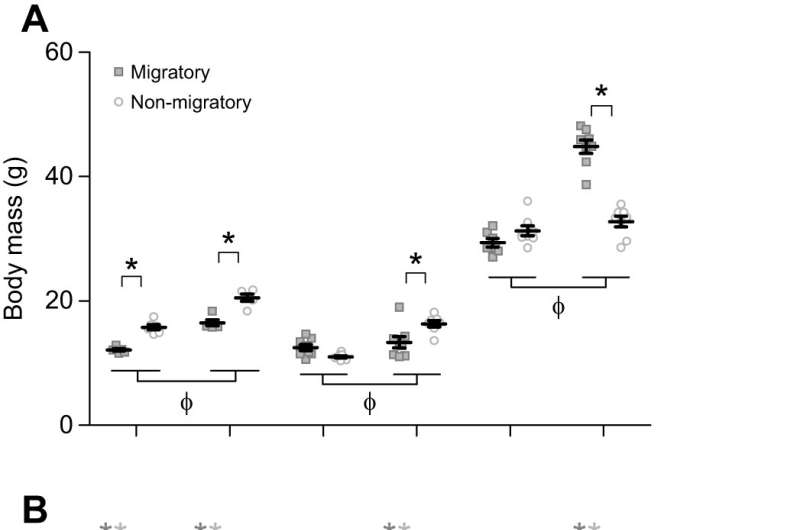This article has been reviewed according to Science X's editorial process and policies. Editors have highlighted the following attributes while ensuring the content's credibility:
fact-checked
peer-reviewed publication
trusted source
proofread
Migratory songbirds found to change breathing patterns to fly at high altitude

Climate change has become a climate catastrophe, say researchers. Earth, water, fire and wind are fighting back and everyone and everything is affected. And that includes the world's bird population.
New research from Western University's Advanced Facility for Avian Research (AFAR) is the first to show that birds adjust their physiology during the migratory season to maintain oxygen uptake and movement to flight muscles, with some species exhibiting greater adjustments than others.
Migration, the regular seasonal movement between breeding and wintering grounds, is greatly affected by climate change (specifically global warming) as birds are forced to encounter and endure changing temperatures, changing humidity, changing altitudes and potentially wildfire smoke to stay cool during flight.
The remarkable modification in breathing pattern, blood-oxygen binding and flight muscle morphology allows the songbirds to fly at much higher altitudes during long distance flights—as much as 4,000 meters (approximately half the cruising altitude of a commercial jet) above sea level—allowing them to avoid major shifts in temperatures and weather patterns caused by climate change.
"Climate change is going to continue heating up the environment and birds need to fly so they can migrate and breed," said AFAR co-director Chris Guglielmo and senior author on the study. "This study shows they need to fly in higher altitudes—and some of them can—to stay in cooler environments or they're not going to survive."
The new study, published in the Journal of Experimental Biology, led by Banting postdoctoral fellow Catherine Ivy investigated how some songbirds, like yellow-rumped warblers, adjust their bodies to inhale and distribute oxygen to blood vessels and flight muscles during the migratory seasons compared to non-migratory conditions.
This study allowed for insights into how songbirds can conduct their long-distance flights during migration and whether these birds are able to migrate in high-altitude conditions (where oxygen availability is limited) to avoid major shifts in temperature and weather conditions because of climate change.

These experiments were conducted at AFAR in the hypobaric climatic wind tunnel for bird flight, unique in the world for the altitudes it can simulate. For the study, Ivy changed the air pressure in the wind tunnel to simulate the birds flying higher and higher in altitude. This allowed her to assess how the changes in oxygen uptake and transport would allow these birds to fly at high altitudes.
"Basically, I wait to see at which point flying becomes more difficult for these birds," said Ivy. "The yellow-rumped warblers were particularly good at this exercise, which was surprising as this species only migrates for 6–8 hours at a time, so we predicted they would not fly very high."
Thrushes, equally common to yellow-rumped warblers in southwestern Ontario, did not show similar seasonal changes in oxygen uptake and movement to flight muscles in this study. Whether these birds can fly as high as yellow-rumped warblers is not known yet, but this will be investigated further this fall in the wind tunnel at AFAR.
"We have discovered that not all songbirds use the same strategy to enhance oxygen uptake and movement to the flight muscle during the migratory season," said Ivy. "For example, during migration, some songbirds adjust their breathing patterns so they can bring in more oxygen to their muscles with each breath. This allows them to maintain flight for six or more hours during migration."
More information: Catherine M. Ivy et al, Migratory songbirds exhibit seasonal modulation of the oxygen cascade, Journal of Experimental Biology (2023). DOI: 10.1242/jeb.245975
Journal information: Journal of Experimental Biology
Provided by University of Western Ontario















